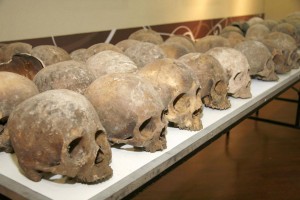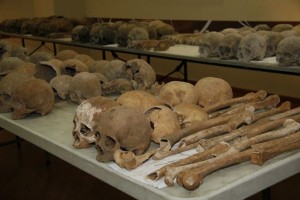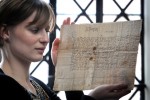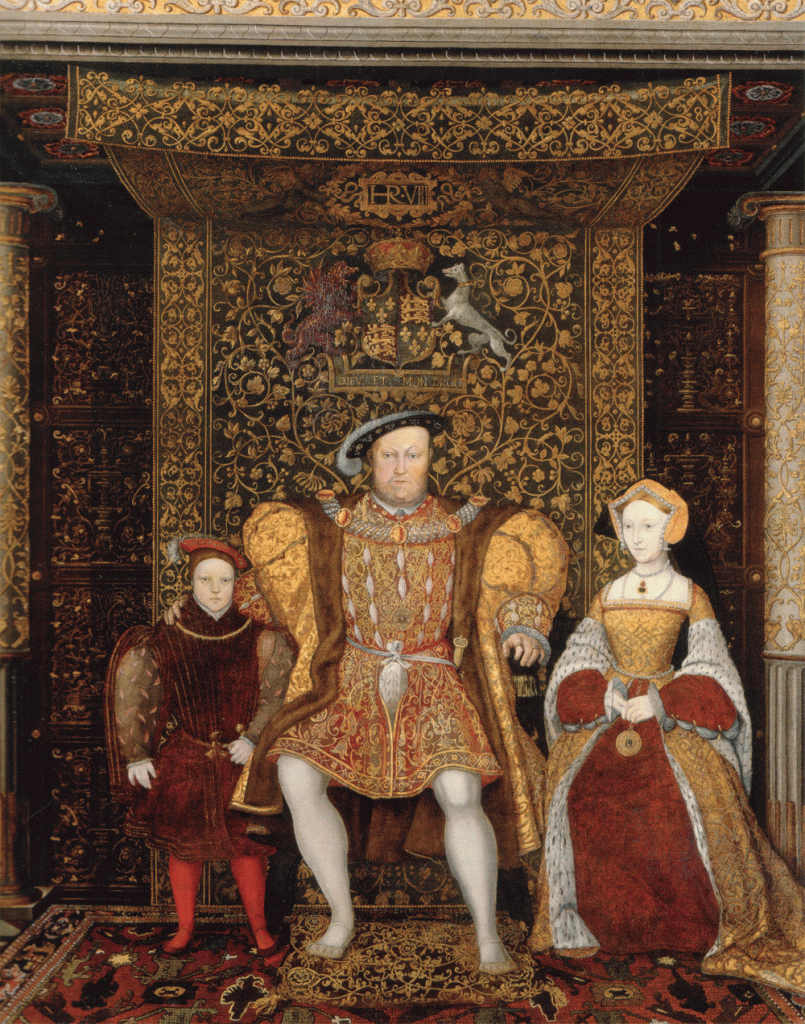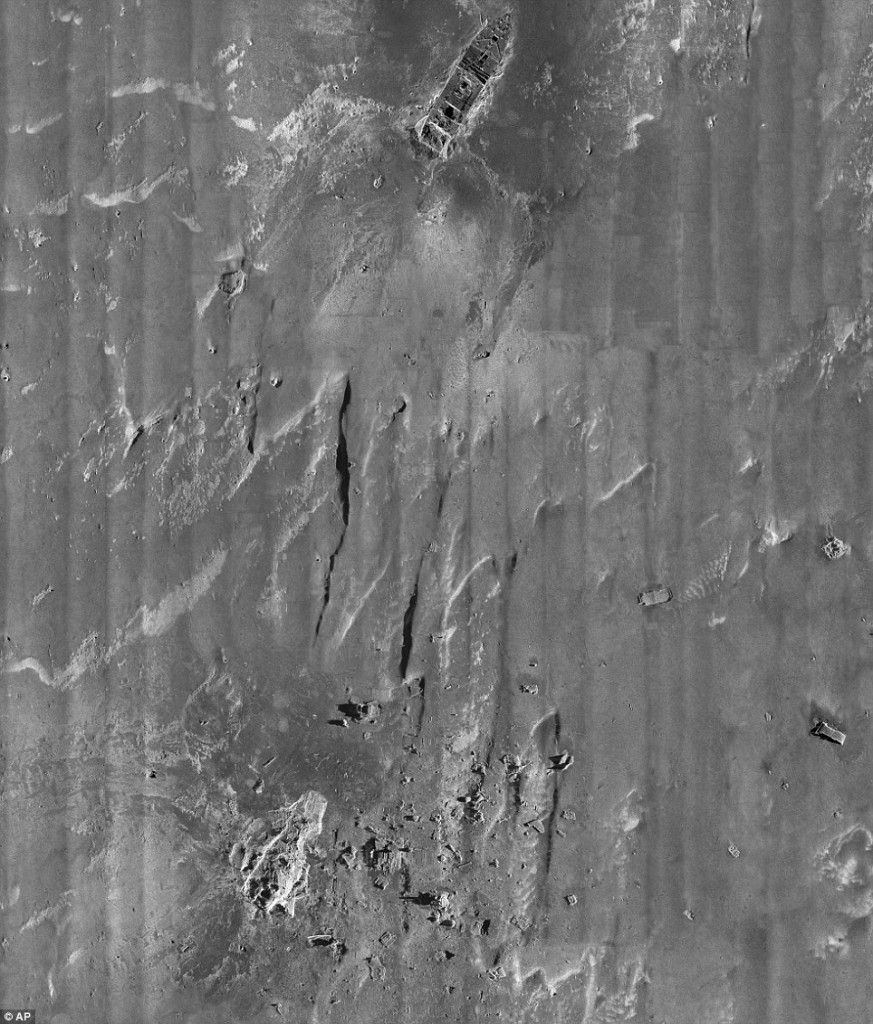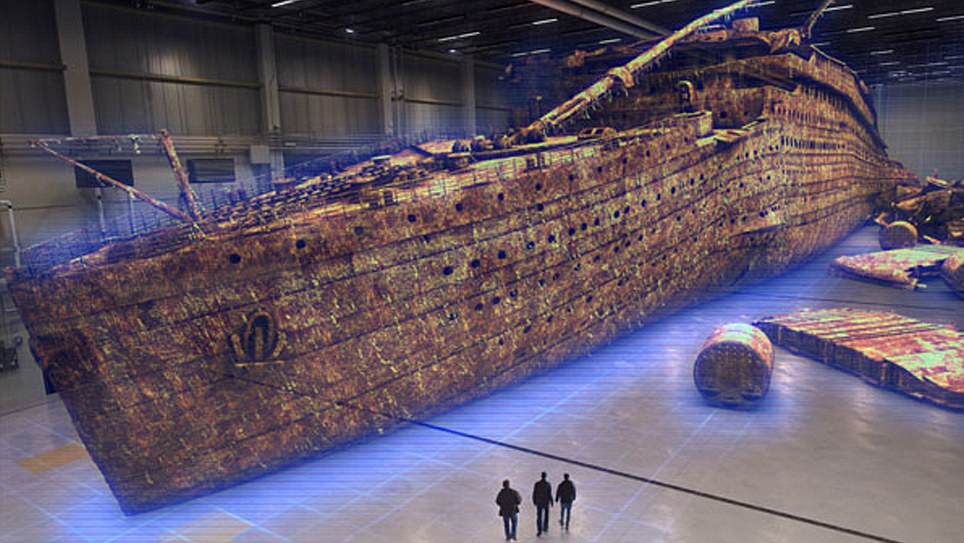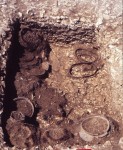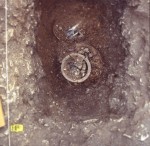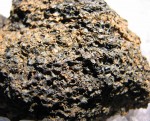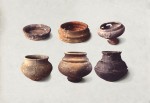 The Cambridge Archaeological Unit has unearthed the 7th century burial of a 16-year-old Anglo-Saxon girl which has two extremely rare features: 1) she was buried in her bed, meaning her actual bed — wooden frame, metal brackets and straw mattress — was buried with her resting eternally upon it, and 2) she was wearing a beautiful gold and garnet pectoral cross. Discovered in the village of Trumpington Meadows three miles south of Cambridge, this is only the 15th bed burial ever found in Britain, and only three of those were discovered in the last twenty years. The cross is only the fifth of its kind ever found.
The Cambridge Archaeological Unit has unearthed the 7th century burial of a 16-year-old Anglo-Saxon girl which has two extremely rare features: 1) she was buried in her bed, meaning her actual bed — wooden frame, metal brackets and straw mattress — was buried with her resting eternally upon it, and 2) she was wearing a beautiful gold and garnet pectoral cross. Discovered in the village of Trumpington Meadows three miles south of Cambridge, this is only the 15th bed burial ever found in Britain, and only three of those were discovered in the last twenty years. The cross is only the fifth of its kind ever found.
How many other graves have been found with a combination of bed burial and cross, you ask? That would be one, at most. There was a reported bed burial and pectoral cross discovered in Ixworth during the 19th century, but the find was poorly documented so it’s not certain what exactly was uncovered there. This girl could very well be one of a kind.
 She was certainly a young woman of wealth. All of the bed burials that have been found in England were of high status people, all of them women, and she was found with particularly valuable grave goods. Most notable is the gold cross, 1.4 inches square, inlaid with red garnets in the same style as the weapon fittings from the Staffordshire Hoard. The four other pectoral crosses that have been discovered in Britain were all pendants, hung from a loop on the top arm. This one has loops on the back of each arm, three of them rubbed shiny, indicating that it was sewn into an article of clothing and worn daily.
She was certainly a young woman of wealth. All of the bed burials that have been found in England were of high status people, all of them women, and she was found with particularly valuable grave goods. Most notable is the gold cross, 1.4 inches square, inlaid with red garnets in the same style as the weapon fittings from the Staffordshire Hoard. The four other pectoral crosses that have been discovered in Britain were all pendants, hung from a loop on the top arm. This one has loops on the back of each arm, three of them rubbed shiny, indicating that it was sewn into an article of clothing and worn daily.
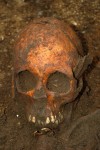 There was also an iron knife buried with her, a chatelaine — a chain meant to hang from the waist — and some glass beads that were probably kept in a purse at the end of the chain. Fragments of fabric were found on the knife and chain, which archaeologists are hoping will allow them to figure out what she was wearing when she was interred.
There was also an iron knife buried with her, a chatelaine — a chain meant to hang from the waist — and some glass beads that were probably kept in a purse at the end of the chain. Fragments of fabric were found on the knife and chain, which archaeologists are hoping will allow them to figure out what she was wearing when she was interred.
Some news outlets are pouncing on this story as omg maybe the earliest Christian grave ever found in Britain omg. Spoiler: it’s not. Not even close. Britain was already largely Christian when the struggling Roman Empire left it to its own devices in 410. Tertullian writes in the early 3rd century that the Britons have been “subjugated to Christ.” Entire cemeteries of Christian Romano-Celts have been found.
The Anglo-Saxons who swept in to pluck the undefended fruit of southern England after the Romans vacated, on the other hand, had their own polytheistic religion which they adhered to consistently for the next two centuries or so. The Celtic Christians in the west and east of England, by now isolated and out of reach of the Roman Church’s hierarchy, don’t seem to have made an effort to convert them. Pope Gregory I stepped into the breach and in 595 sent St. Augustine of Canterbury, so named because he would become the first archbishop thereof, to convert Æthelberht, the pagan King of Kent whose wife was a Christian Merovingian Frank. Augustine reached Kent in 597 and converted Æthelberht and a great many of his subjects before the year was out.
 Now, since the young lady with the cross has not yet been radiocarbon dated we don’t have an absolute date for when she died, but bed burials thus far have only been found within a narrow range of the mid to late 7th century, and the gold and garnet cross stylistically dates the burial to somewhere between 650 and 680 A.D. That means she was Christian, either converted or born, less than 80 years after the first Anglo-Saxon conversions. Our maiden could therefore be the first Anglo-Saxon Christian burial ever found, and she’s without question one of the earliest.
Now, since the young lady with the cross has not yet been radiocarbon dated we don’t have an absolute date for when she died, but bed burials thus far have only been found within a narrow range of the mid to late 7th century, and the gold and garnet cross stylistically dates the burial to somewhere between 650 and 680 A.D. That means she was Christian, either converted or born, less than 80 years after the first Anglo-Saxon conversions. Our maiden could therefore be the first Anglo-Saxon Christian burial ever found, and she’s without question one of the earliest.
The only other grave remotely like hers, the one found in Ixworth in the 19th century, was not excavated or documented with archaeological practices, so archaeologists are tremendously excited to have an opportunity to examine in detail with all modern technology a grave from this important transitional period in British history.
“The Trumpington bed burial does seem to belong at that transition between the two religions. Did she have a formal role in the church? The site is just behind the village church, which is first documented over 400 years later. Perhaps there was a monastery – even a nunnery – there before that we don’t know about. This is certainly something worth looking into.”
A small number of structures associated with the burials seem to represent part of a settlement that was in use at the same time. Analysis of the finds from these will help to determine the nature and function of that settlement; initial assessment of the pottery has suggested the presence of some high status imports, of a type usually only associated with high status ecclesiastical centres.
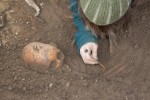 The Christian girl isn’t the only person from this era buried at the site. Her grave was one of four grouped together. Two of the graves also held the remains of young women and the third held a person whose sex has yet to be determined. The remains will all be radiocarbon dated to confirm that they were indeed contemporaneous burials. Isotope analysis on their teeth will determine where they lived as children and what kind of diets they had. Researchers are also hoping to pinpoint the causes of death and any other illnesses or injuries they suffered in life.
The Christian girl isn’t the only person from this era buried at the site. Her grave was one of four grouped together. Two of the graves also held the remains of young women and the third held a person whose sex has yet to be determined. The remains will all be radiocarbon dated to confirm that they were indeed contemporaneous burials. Isotope analysis on their teeth will determine where they lived as children and what kind of diets they had. Researchers are also hoping to pinpoint the causes of death and any other illnesses or injuries they suffered in life.
Cambridge has put together a neat video of the discovery. I love how the archaeologist who was excavating the skeleton when she first brushed dirt off the edge of the cross thought it was a pound coin one of her colleagues had thrown in as a joke.
Pictures courtesy of Cambridge University. You can see more of them on their Flickr page.
